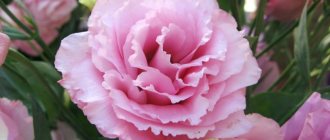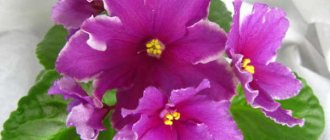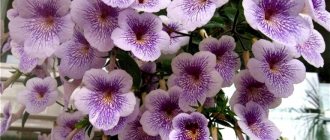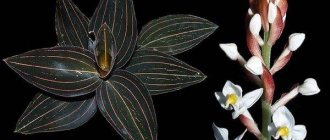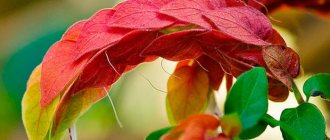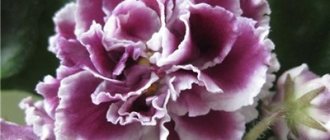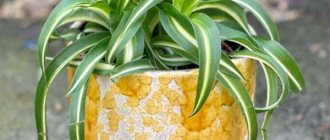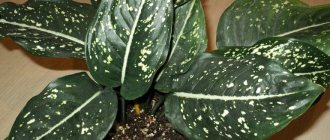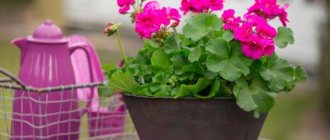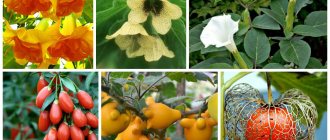Translated from ancient Greek, achimenes (genus Achimenes Pers) is translated as “afraid of the cold.” This herbaceous perennial, native to South and Central America, Jamaica, Mexico, belongs to the Gesneriev family and, along with gloxinia and violet, is considered one of its most beautiful representatives.
The crop was first brought to England from Jamaica in 1778, and quickly gained popularity during the Victorian era. Interestingly, Achimenes is also known as the “hot water plant”, since it was previously mistakenly believed that hot watering promotes abundant flowering.
Description
The main advantage of the culture is its long, magnificent, abundant flowering, which lasts from the end of May to October, which is due to the constant development of new buds.
Funnel-shaped flowers with a long tubular corolla appear from the leaf axils. Their color range is striking in its richness of colors and shades - from beige to inky purple.
Many species feature stunning double flowers, some monochromatic, others two or three colors often with a contrasting colored center. Some breeders classify Achimenes by color group: yellow, pink, purple, white.
The leaves of the plant are heart-shaped, shiny, with jagged edges; in some varieties, the leaves on the reverse side are purple or pink.
In cultivation you can find ampelous varieties with long hanging shoots and a bushy growth form. Slightly pubescent stems grow from underground rhizomes, some of them resemble small scaly pine cones, others are round or pear-shaped.
Achimenez George Houche: description
It blooms for more than 5 months a year, is unpretentious in cultivation, and resistant to diseases.
The flower is suitable for both beginners and experienced gardeners. Flowering begins from the end of May until the onset of cold weather. In winter, its entire upper part dies off, leaving only the rhizome. It can be dug up and stored in a plastic bag with peat or other fertilizer. From one rhizome, about 2-8 grow by the end of the season.
Popular indoor species and some varieties of Achimenes
There are about 40 types of culture in nature. Many of them have been widely hybridized and most hybrids are obtained from crossing the large-flowered species A. grandiflora and A. longiflora. For example, the hybrid "Purple King" combines numerous varieties with purple or blue flowers.
Purple King
We will describe these two species, which are most often grown at home. The varieties of Achimenes are so numerous that it is impossible to describe and list each of them.
Achimenes Longiflorum is native to Guatemala. Grows up to 30 cm in height. Stems and leaves are slightly pubescent. The growth form is ampelous. The flowers are large purple with a long narrow tube.
Well-known varieties obtained from hybrid forms: snow-white “Alba” and “Ambroise Verschaffelt” with purple lines along the flower, the well-known double large-flowered variety with petals of delicate yellow, cream and pink shades “Yellow English Rose”, “Major” with large blue flowers.
Achimenez Yellow-English-Rose
Achimenes grandiflora. The height of the spreading bush is from 30 to 60 cm. The stems are pubescent, vertical, green or reddish in color. The leaves are green on the outside and pale green or purple on the back.
A characteristic feature is large flowers and a huge variety of varietal forms.
The most impressive:
— blue-violet with a bright yellow or white core “Dark Matte”;
— created in 2011, the profusely blooming “Honey Queen” with yellow flowers and a slight pink tint along the edges of the petals;
— “Queen Of Lace” double huge white flowers with a delicate lilac tint on the petals;
— “Abendrot” is a unique varietal creamy-lilac form of the 2012 series with extremely large flowers - a double version of “White Glory”;
Abendrot
— terry canary “Hot Spot” with cherry irregular spots on the petals;
— “Rainbow warrior” with large lilac flowers;
— cream with a delicate pink tint “Cote d Ivoire”.
— soft pink “Ice Tea”.
Other varieties
In addition to the varieties described above, the following plant varieties are distinguished among Achimenes:
- The Abendrot variety blooms with large double yellow flowers with a lavender sheen. Tolerates direct sunlight and blooms profusely. The plant has ampelous shoots on which green leaves grow. Grown in the form of hanging flower pots.
- The Alaska Dream variety has erect branches with large white double flowers. There are also plants of this variety with lavender flowers and greenish leaves. It is grown only outside - in the garden.
- The compact variety Amile Saliba blooms with large, simple, yellow flowers with orange petal edges. The plant has light green leaves.
- The Anastasia variety has large flowers, a unique shape, light pink in color, and golden yellow in the center. Light green foliage grows on erect shoots.
- The Argentina variety blooms with medium-sized flowers with whitish-blue corollas and a large golden-yellow spot with brown shading. Dark green leaves are located on erect shoots. The plant is compact, climbs independently with its shoots, and blooms profusely.
- The Ballerina variety produces large red-brown flowers on straight shoots. In the center of each flower there is a yellow spot with a brown splash. The foliage is green on top and burgundy below.
- The Bird of Paradise variety blooms with medium-sized raspberry-pink flowers that bloom on hanging shoots. Around the throat on each flower you can see yellow and lilac dots. The foliage is dark green on top and burgundy underneath.
- The Firenze variety blooms with large lilac or pink flowers. On straight branches you can see dark green leaves, which, when exposed to too much light, take on a reddish-brown tint.
- The Blue Bird variety produces blue-violet flowers with jagged, wavy petals on erect shoots. The foliage is dark green.
- The Hybrid variety blooms with medium-sized bright red flowers that bloom on erect shoots. A red flower with a salmon-colored sheen and yellowish dots in the center. The dark green leaves have burgundy veins.
In addition to the varieties described above, there are other varieties of Achimenes. Thanks to this diversity, flower growers choose a more suitable plant for cultivation at home or in the garden, plant it and properly care for it.
Features of caring for Achimenes at home
Basic care for Achimenes at home begins in early spring and continues until mid-October. This is due to the life cycle of the plant, which we will discuss below. In general, the crop is not considered capricious and is quite easy to grow.
Lighting
The plant needs to be provided with bright, diffused light, which stimulates beautiful and abundant flowering.
The best exposure will be east or west windows.
A lack of lighting leads to elongated shoots and poor and dull flowering. On the south side, protect the bush from direct midday rays by creating an artificial shadow made of fabric or paper.
Temperature
The optimal temperature during the growing season is 20-25 °C. At higher temperatures, the buds do not open, the flowers fall off, and the leaves wither.
The plant reacts negatively to drafts, sudden temperature changes and cool conditions during the flowering season.
Ivory-Queen
Watering and humidity
In spring and summer, when plant growth is active, regular heavy watering is recommended, but the procedure is carried out only after the top layer of soil has dried out a little. For all its moisture-loving nature, Achimenes does not tolerate stagnation of water, which leads to rotting of the tubers.
Methods for propagating Achimenes
At home, Achimenes propagates by dividing underground and aerial rhizomes, apical or leaf cuttings and seeds.
Reproduction by rhizomes
The first method is the simplest, since the rhizomes take root very quickly. We carry out propagation during plant transplantation.
We select healthy, dense roots, divide them into two or three parts, sprinkle the sections with ground cinnamon and place several in a pot in a substrate moistened with warm water.
Then we cover it with a layer of soil and cover it with film to create greenhouse conditions.
We place the pot in partial shade. We moisten the earth periodically.
After 2-3 weeks you can see the first shoots. We remove the cover and place the pot with young plants in a well-lit place.
In some hanging varieties, aerial roots-rhizomes are formed on the shoots. They can be separated with part of the stem and placed in the ground for rooting.
Propagation by cuttings
A more labor-intensive method of propagation by cuttings. For rooting in summer, take apical cuttings 6-7 cm long or large healthy leaves. The lower leaves of the cuttings are torn off.
Cuttings and leaves are placed in water or placed in a damp mixture of sand and flower soil and covered with a plastic bottle or bag. Maintain moderate soil moisture. Roots form in about two weeks.
The method has a significant drawback - by the time it is time to retire, the rhizomes have not yet had time to accumulate nutrients and the plant will be very weak. And without a dormant period there will be no flowering.
In this case, flower growers recommend supporting the growth of young bushes for as long as possible with the help of phytolamps and watering, and only allowing them to fall asleep at the end of November.
Rooted leaf cuttings
Propagation by seeds
The seed method does not transmit the varietal characteristics of the parent plant, so it is better to sow purchased seeds. Sowing is carried out at the end of winter in a moist mixture of soil and sand. Place the container in partial shade and periodically spray the soil.
For rapid germination, it is better to cover the container with film, which we periodically remove for ventilation. When the first 2-3 leaves appear on the seedlings, they are picked and transplanted into separate pots of 3-4 sprouts. At the stage of 6-7 leaves, we pinch the top to stimulate branching.
How to care
We distribute the seedlings into pots, three roots in each. The pot should be low and wide, each 2.5 cm deep. Hanging flowerpots are also suitable. Sprouts begin to appear after about a month of planting. The choice of soil should be carefully considered.
The substrate must be permeable. In heavy soil, roots will take a long time to germinate and develop worse. Coconut is a suitable substrate; it needs to be soaked in a large container and left until the water is completely absorbed. Pour the mixture into the pot and add sand on top. We exclude perlite and vermiculite, they have a bad effect on the plant.
We use fertilizing first; four waterings will be enough. It is better to moisten lightly so as not to damage the sprouts. It is advisable to propagate the plant in the spring, because in the summer it already blooms. A peat tablet is best suited for these purposes.
At the first rays of sun, the plant can be taken out to the balcony. We place the pot away from the scorching sun. Flowering begins at the end of May. In hot weather, the plant is watered abundantly, but it should not be overwatered - it may rot. The first buds need to be fertilized with mineral fertilizers containing phosphorus and microelements. By September we stop feeding, the plant is preparing for a dormant period.
Plants need the clothespin method. It involves cutting off the apical bud with scissors. It is better to do this the first time at the early stage of flowering, when the growth is 2 cm in length, then several more times as it grows. The need for using this method is that the shoots become strong, the leaves grow and more flowers appear.
Problems in care
The crop reacts to low air humidity by drying out the tips of the foliage. Yellowing and darkening of leaves is a symptom of drying out soil or lack of nutrients. Fertilizer deficiency also leads to shredding of flowers. When overwatered, the leaves of Achimenes curl.
How to deal with mold in a pot
Infectious diseases develop most often in specimens grown outdoors. But sometimes the plant can be affected by powdery mildew or gray mold. This occurs mainly due to over-watering and high humidity along with cool conditions.
You should immediately limit watering, move the pot to a warm and well-lit place, and treat the flower with a fungicidal preparation.
It is most susceptible to attacks from the following insects: aphids, thrips and spider mites. At the first sign of infestation, take immediate measures to combat these dangerous insects.
Author: Yulia Zakrevskaya
- Moisture-loving
- Beautifully flowering
- Unpretentious
- Ampelous
Comments
Diana 04.11.2017 16:52 Stunningly beautiful flowering.
special for terry varieties! Answer
Ira 11/28/2017 5:23 pm I have never seen a more beautiful flower with such simple care. And it reproduces quite simply. I have 3 different beautiful varieties and 5 flowers. All grew easily from rhizomes.
Answer
Nina 11.29.2017 20:34 Has anyone tried to root with a leaf? How is it going?
Answer
Yulia 03.12.2017 13:56 I rooted with a leaf. There are no problems.
Answer
Natalya 12/05/2017 20:21 I have always admired this flower. Its rhizomes are so interesting, and its flowering is something special!
Answer
Svetlana 12/07/2017 19:43 Can you take it outside as landscaping?
Answer
Irina 12/11/2017 20:44 Of course you can, but only in partial shade. I hang hanging views near the entrance to the house. Very beautiful. You can also put them in pots.
Answer
Update list of comments
